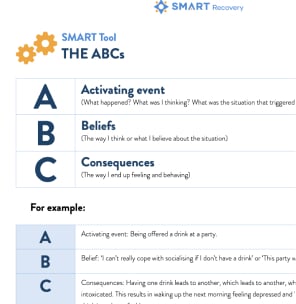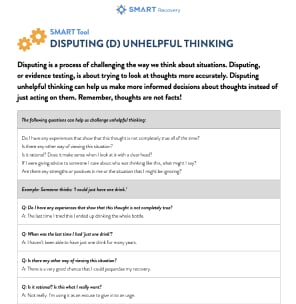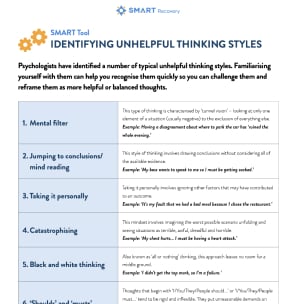Tool Overview
It is very common for us to feel ambivalent about making a change. We may be able to see the potential benefits of stopping or cutting down, but we can also be reluctant to give up the good things we associate with the behaviour of concern, or we may not yet have thought through the consequences fully. Until we explore both sides (benefits and consequences) of our behaviour, we may find it difficult to commit to making a change. The cost benefit analysis (CBA) can help us to find the motivation and make a decision about changing a behaviour.
The CBA encourages us to write down both the pros (positives) and the cons (negatives) about the behaviour we are thinking of giving up or changing. Although at first glance this may seem very simple, seeing all of the pros and cons in black and white can be powerfully motivating and can often tip us from precontemplation into the contemplation and preparation stage of change.
The CBA can be useful in any situation where a change is being considered; it doesn't only apply to behaviors of concern. For example, before getting into an argument with a partner, we might apply a CBA by asking if it is worth it.
When to Use This Tool
a) To explore Motivations to Change
This tool is useful for us to understand our motivations for change as well as reasons for why we engage in our specific behaviour. During check in at a SMART meeting participants share why they are attending and what they want to change. A CBA can then be utilised in Work Time to explore further how that behavior is impacting our lives using questions such as:
-
“Tell me more about how your alcohol is affecting you,
-
What areas of your life is it impacting the most
-
If you do not make a change what will happen?” (consequences)
It also gives an opportunity to explore the reasons we engage in the behaviors we do, by looking at the “payoffs” or benefits of the behavior using questions such as:
-
“What are the reasons you use alcohol?
-
What benefits do you get from using it?
It is important to explore the benefits as well as the consequences of the behaviors we engage in as we may need to find alternative ways to obtain these benefits once we give up the problematic behaviour.
b) To help develop discrepancy
Particularly in the precontemplation stage of change, it can be useful to look at the discrepancy between our behaviour and our hierarchy of values. The CBA tool can help to highlight a misalignment. E.g. ”My family is the most important thing to me but if I keep going with this behaviour I could lose my job and this will affect my family”
c) To maintain motivation when we may be in danger of lapsing:
During the stage of maintenance, complacency can rear its head. We may begin to think about “just once / just one time”. We can start to miss the “good” things about the substance or behaviour and start to forget the negatives / consequences of it which became a problem. A CBA at this time can be really beneficial to remind us of the reason we wanted to change in the first place.
How To Use This Tool
Additional Considerations
Related Tools
View all- Tool
Rating Scale
Sometimes participants may lack the confidence to make a change, even though changing is important to them. When considering a participant’s readiness to change, it can be helpful to weigh up not only how important it is to them, but also how confident they feel about being able to achieve the change they want.
- Worksheet
Change-Plan
The change plan worksheet captures and organizes essential elements of a plan, including desired changes, reasons, steps, helpers, success indicators, and obstacles.
- Tool
Maintaining Motivation
The maintaining motivation worksheet encourages us to remind ourselves why we wanted to make our change. It asks us to think about how far we’ve come and how the changes we’ve made have impacted our life.
Tool Overview
The ABC Model is a good way of understanding how we can help change our feelings and behaviour by challenging our thinking.
When to Use This Tool
The ABC Model is a good way of understanding how we can help change our feelings and behaviour by challenging our thinking. It helps us uncover beliefs that are not helping us /contributing to the behaviour we are trying to change.
This exercise may be done in the group setting but can also be very useful for participants to look at between meetings.
How To Use This Tool
When working with urges: To analyze a lapse/relapse or to develop coping statements for an anticipated lapse/relapse.
In the event of a lapse, the question to ask is not “What made me do that”, but rather, “How did I talk myself into it?” It is not the urge (A) that causes the lapse (C). It is our beliefs (B); our irrational self-talk.With emotional upset:
The ABC Model can also be used to work with emotional upset or frustrations that may occur at any point in the recovery journey. The ABCs allow us to discover our unhelpful beliefs which contribute to emotional upsets. Disputing helps us eliminate our irrational thinking so we can both feel better and do better. In SMART Recovery we teach that we feel the way we think; it’s not unpleasant events that disturb us, it’s the way we think of them. By changing our thinking, we change how we feel.Identifying and Disputing Unhelpful Thinking.
Disputing is a process of challenging the way we think about situations. It’s about trying to look at thoughts more accurately. Disputing unhelpful thinking can help us make more informed decisions about thoughts instead of just acting on them. Balanced thinking leads to effective new beliefs.



